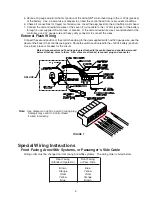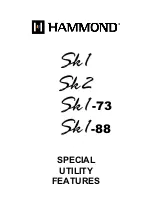
4
7)
Loosely mount the ArrowStik
®
bracket to the lightbar as shown in Figure 6.
8)
Loosely mount the ArrowStik
to the bracket as shown in Figure 4.
9)
Put the lightbar on the vehicle roof making sure not to scratch the vehicle. Check for clearance below
the lightbar as you proceed.
10) Reposition the lightbar and secure it to the vehicle.
11) Tighten the bolts that hold the ArrowStik
mounting bracket to the lightbar, checking that they are in the
same position front to back with respect to the mounting bracket.
12) Position the Arrowstik
in the center of the vehicle and tighten the bolts that hold it to the mounting bracket.
Note:
See Special wiring instructions for 9 wire cable and AS6FL.
Refer to Figure 7 for control head installation.
1. After installing the ArrowStik
lighthead, route the cable into the vehicle to where the Arrowstik control head
will be mounted.
2. Cut the cable to length and strip back the cable insulation on the seven (7) wires.
3. Remove the plug from the back of the control head. Connect the colored control wires to the plug as shown
on the control head decal.
4. Route a user supplied 12 gauge black wire to the battery ground (earth) (negative). Use the crimp
connector in the parts bag and connect to the black 12 gauge wire on the ArrowStik control head.
FIGURE 6
XL 5000 SERIES
CARRIAGE
BOLT
FIGURE 5
XL 5000 SERIES
U-BRACKET
ASSEMBLY
5
16
"
ACORN NUT
PLASTIC SHIM
MOUNTING BRACKET
5
16
"
Larger wires and tight connections will provide longer service life for components. For high
current wires it is highly recommended that terminal blocks or soldered connections be used
with shrink tubing to protect the connections. Do not use insulation displacement connectors
(e.g. 3M
®
Scotchlock type connectors). Route wiring using grommets and sealant when
passing through compartment walls. Minimize the number of splices to reduce voltage drop.
High ambient temperatures (e.g. underhood) will significantly reduce the current carrying
capacity of wires, fuses, and circuit breakers. Use "SXL" type wire in engine compartment.
All wiring should conform to the minimum wire size and other recommendations of the
manufacturer and be protected from moving parts and hot surfaces. Looms, grommets, cable
ties, and similar installation hardware should be used to anchor and protect all wiring.
Fuses or circuit breakers should be located as close to the power takeoff points as possible
and properly sized to protect the wiring and devices.
Particular attention should be paid to the location and method of making electrical connections
and splices to protect these points from corrosion and loss of conductivity.
Ground terminations should only be made to substantial chassis components, preferably
directly to the vehicle battery.
The user should install a fuse sized to approximately 125% of the maximum Amp capacity in
the supply line to protect against short circuits. For example, a 30 Amp fuse should carry a
maximum of 24 Amps.
DO NOT USE 1/4" DIAMETER GLASS FUSES AS THEY ARE NOT SUITABLE FOR
CONTINUOUS DUTY IN SIZES ABOVE 15 AMPS.
Circuitbreakers are very sensitive to high temperatures and will "false trip" when mounted in
hot environments or operated close to their capacity.
!
WARNING!
Wiring Instructions
Summary of Contents for ARROWSTIK AS-10
Page 10: ...FIGURE 10 7 6 1 9 2 3 4 11 12 13 10 14 16 5 15 8 10...
Page 11: ...Notes 11...






























